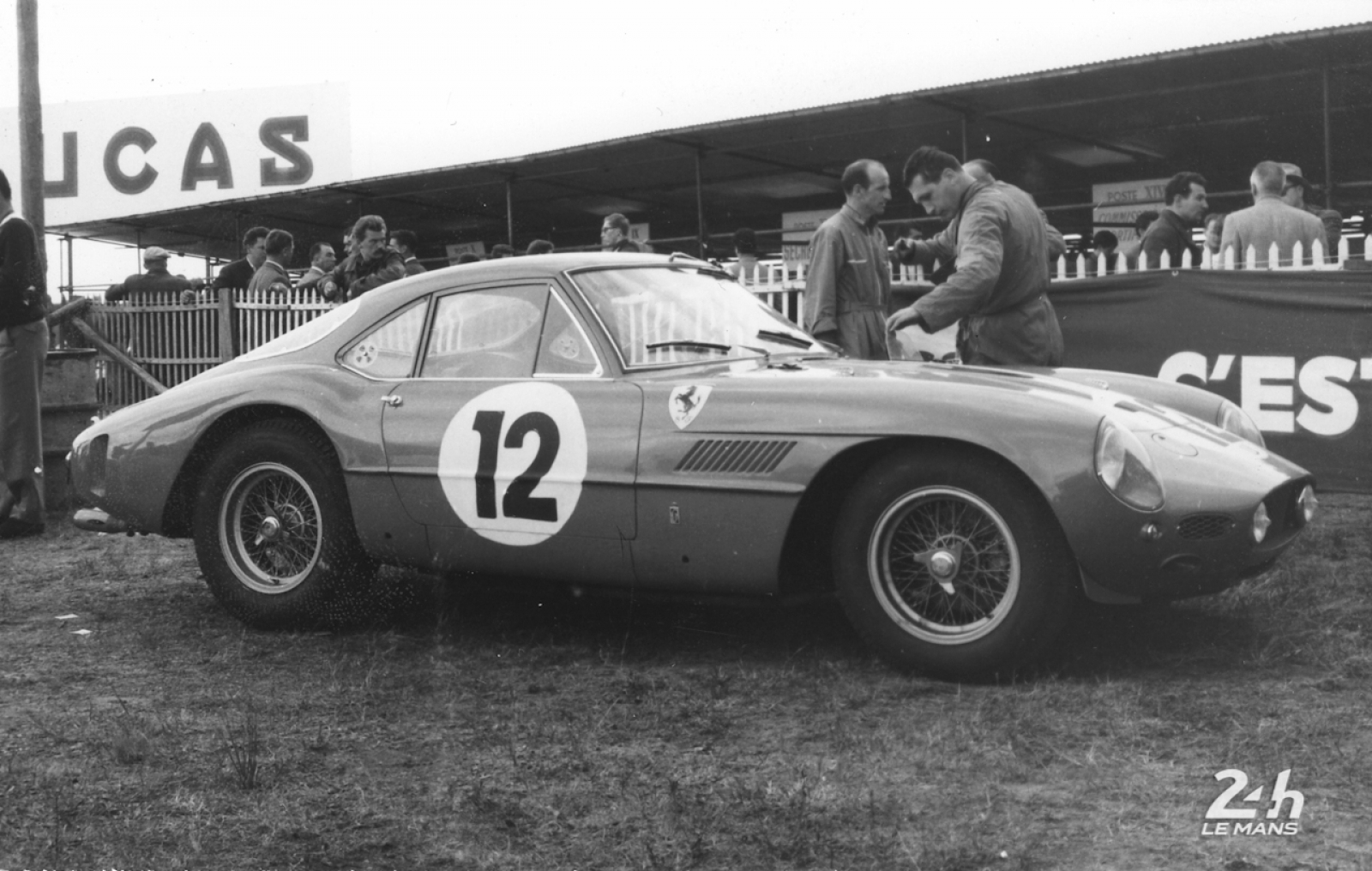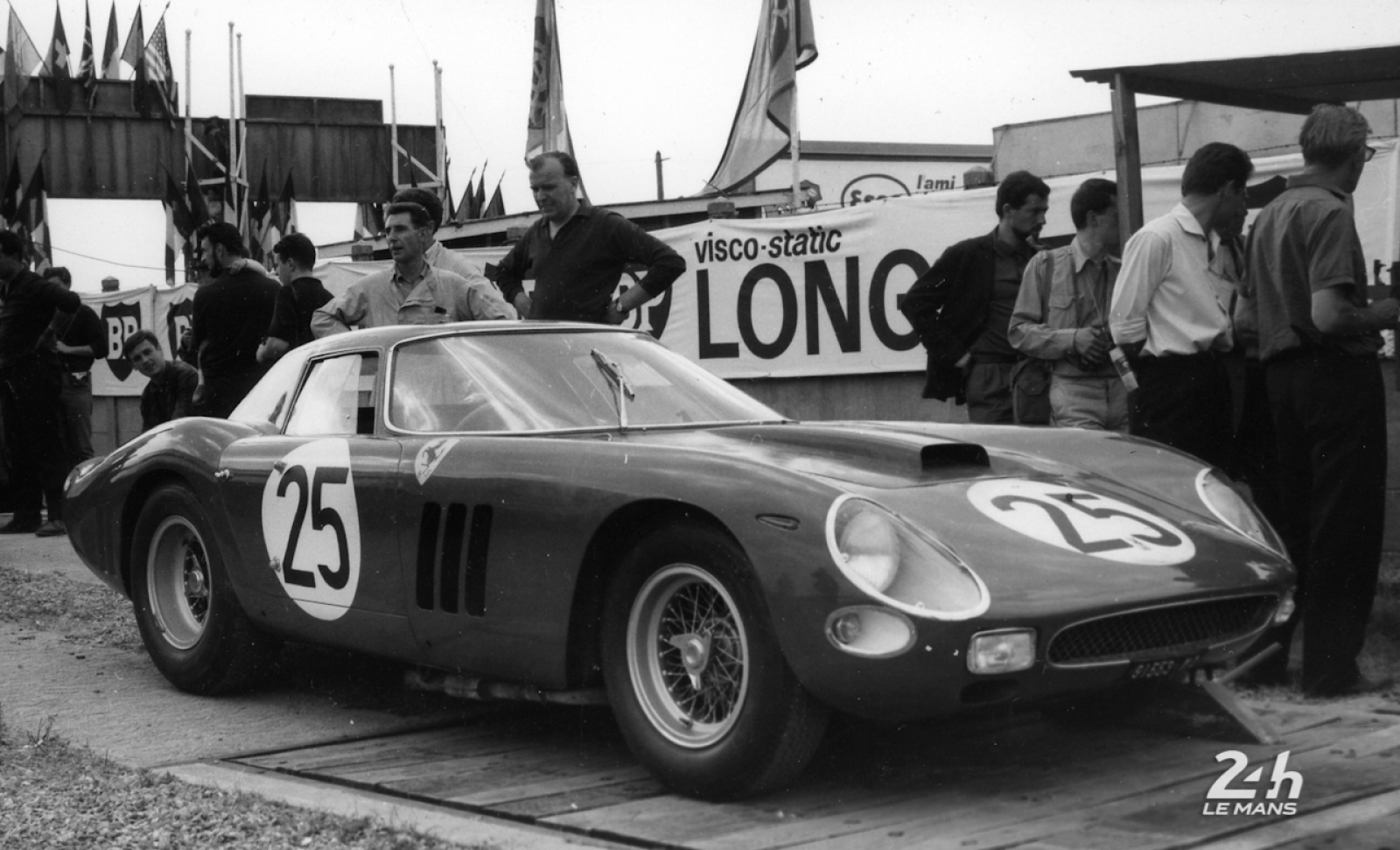Ferrari's string of six consecutive wins at the 24 Hours coincided with the heyday, on the track and the road, of the different versions of the 250, the first of which dated back to 1952. Twenty-six variations of the Ferrari 250 crossed the finish line at the race from 1960 to 1965, and five of the marque's nine victories were won by a car sporting this number. Now considered a legend in the saga of Ferrari, the number originally designated the unit volume of its engine, i.e. 250 cm3 for each of its twelve cylinders, arranged in a V.
250 TR, two patronyms, two legends – Having first appeared in 1957, this Ferrari was also known under the name Testa Rossa (TR), a reference (literal translation: red head) to the colour of the engine cylinder head covers immediately noticeable once the bonnet is open. At the wheel of this car, Olivier Gendebien won three of his four wins at the 24 Hours, in 1958 and 1961 with Phil Hill, and in 1960 with Paul Frère. In 1962, the Testa Rossa label was also given to the 330 of Gendebien-Hill, the last front-engine prototype to win at Le Mans.
250 GT SWB, perfection – In 1959, this version marked the birth of the road 250 GT. To optimise maneuverability, its wheelbase (the space between the front and rear axles) was reduced by 20 cm, from 2.60 m to 2.40 m. This earned it the moniker SWB (for short wheelbase), however not officially recognized by Ferrari. This 250 GT SWB was available with a steel body (for the road) or aluminum body (for competition). In 1960 and 1961, six 250 GT SWBs finished in the top 10 at the 24 Hours, with as best result third place for Jean Guichet and Pierre Noblet in 1961. That year, a very special 250 took the start in the race. Nicknamed "Sperimentale" (experimental) by Italian journalists, the car was painted in French blue to welcome as a factory driver Le Mans area native Fernand Tavano (joined by Giancarlo Baghetti). Forced to retire, this 250 predated one of the most iconic Ferrari's ever, set to make its first appearance the next year.
250 GTO, the legend – On 24 February 1962, during the annual presentation of competition Ferrari's in the courtyard of the Maranello factory, the press discovered the 250 GTO (for "Gran Turismo Omologato"). Compared to the 250 GT, its aerodynamics were optimised by a plunging front, back set V12 engine and a truncated rear with a spoiler. In 1962, the renowned GTO finished its first 24 Hours in second (Jean Guichet-Pierre Noblet) and third (Jean Blaton-Léon Dernier) places. The following year, two Belgian GTOs made it into the top 5 thanks to Jean Blaton-Gérald Langlois von Ophem (second) and Léon Dernier-Pierre Dumay (fifth). In 1964, the GTO finished in the top 10 once again, thanks to Lucien Bianchi-Jean Blaton (fifth), Innes Ireland-Tony Maggs (sixth) and Fernand Tavano-Bob Grossman (ninth). This exceptional achievement was followed up with three consecutive wins in the World Marques Championship (1962-63-64). Its track record and rareness (only thirty or so units were produced) make the GTO cost a fortune on the collection cars market, and happy owners form the elite of Ferrari lovers.
250 P, an Italian exception – In 1963, the only participation for the Ferrari 250 P in the 24 Hours ended in victory (Lorenzo Bandini-Ludovico Scarfiotti) and third place (Umberto Maglioli-Mike Parkes). A third car took the start, but its drivers John Surtees and Willy Mairesse were forced to retire in the lead with a fire in the 19th hour. The 250 P also marked a key date in the history of race as the first rear engine car to win at Le Mans. Bandini and Scarfiotti formed the only all-Italian driver line-up to win the 24 Hours at the wheel of a Ferrari.
250 LM, the last victory – Presented at the Paris Motor Show in 1963, two 250 LMs were first fielded in the 24 Hours in 1964, but only one made it to the chequered flag (16th), with at the wheel Pierre Dumay-Gérald Langlois von Ophem. The car tasted glory the following year: after the retirement for factory prototypes 330 P2 and 275 P2, a duel between Ferrari partner teams pitted North American Racing Team (NART) against Ecurie Francorchamps. They finished in this order in the top two spots thanks to Masten Gregory-Jochen Rindt (winners) and Pierre Dumay-Gustave Gosselin (second). This one-two was rounded out by another partner team, the Swiss outfit Scuderia Filipinetti, sixth thanks to Dieter Spoerry-Andreas Boller. The 250 LM was seen again at Le Mans in 1966, 1968 and 1969.
PHOTOS: LE MANS (SARTHE, FRANCE), CIRCUIT DES 24 HEURES, 24 HOURS OF LE MANS. From top to bottom, the 250 TR of Belgian duo Olivier Gendebien-Paul Frère, winners in 1960 (#11); two versions driven at the race by Le Mans native Fernand Tavano: the 250 GT SWB in 1960 (#16) and the 250 called Sperimentale in 1961 (#12); the 1964 vintage version of the mythical 250 GTO (#25): pictured here, the one entered by British team Maranello Concessionaires, sixth thanks to Innes Ireland-Tony Maggs.




